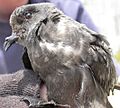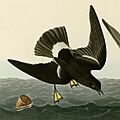Northern storm petrel facts for kids
Quick facts for kids Northern storm petrels |
|
|---|---|
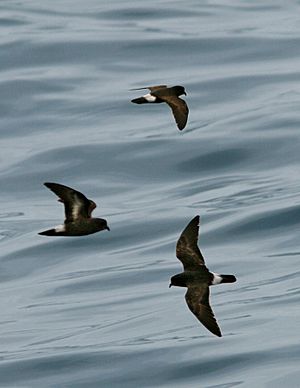 |
|
| European storm petrels | |
| Scientific classification |
|
| Kingdom: | Animalia |
| Phylum: | Chordata |
| Class: | Aves |
| Order: | Procellariiformes |
| Family: | Hydrobatidae |
| Subfamily: | Hydrobatinae Mathews, 1912 |
| Genus: | Hydrobates F. Boie, 1822 |
| Type species | |
| Procellaria pelagica (European storm petrel) Linnaeus, 1758
|
|
| Species | |
|
See text |
|
| Synonyms | |
|
Oceanodroma Reichenbach, 1853 Thalassidroma Vigors, 1825 Zalochelidon Billberg, 1828 Cymochorea Coues, 1864 Halocyptena Coues, 1864 Pacificodroma Bianchi, 1913 Bannermania Mathews & Iredale, 1915 Tethysia Mathews, 1933 Loomelania Mathews, 1934 Bianchoma Mathews, 1943 Stonowa Mathews, 1943 Thalobata Mathews, 1943 Hydrobatinae (Mathews, 1912) |
|
Northern storm petrels are small seabirds found in the genus Hydrobates. They belong to the family Hydrobatidae, which is part of a larger group of birds called Procellariiformes. These birds were once grouped with similar birds called austral storm petrels. However, scientists later found they were not closely related and split them into separate families.
Northern storm petrels are the smallest seabirds. They eat tiny sea creatures like planktonic crustaceans and small fish. They pick their food from the water's surface while hovering. Their flight looks like a butterfly's or even a bat's.
These birds live mainly in the Northern Hemisphere, though some near the Equator can be found a bit further south. They spend almost all their lives at sea, only coming to land to breed. It's hard to study them in the wild, so we don't know much about their lives at sea. They nest in large groups, usually returning to the exact same spot where they were born. Most species nest in cracks or burrows. All but one species visit their breeding colonies at night to avoid predators. Pairs stay together for many years and share the jobs of incubating their egg and feeding their chick. Like many seabirds, raising their young takes a long time. The egg can take up to 50 days to hatch, and the chick takes another 70 days to be ready to fly.
Sadly, some northern storm petrel species are threatened by human activities. One species, the Guadalupe storm petrel, is believed to be extinct. The biggest danger to storm petrels comes from introduced species, especially mammals like rats and feral cats, on their breeding islands. These birds usually nest on isolated islands where there are no mammals, so they can't protect themselves from these new predators.
Up and down! - up and down!
From the base of the wave to the billow’s crown,
And amidst the flashing and feathery foam
The stormy petrel finds a home, -
A home, if such a place may be
For her who lives on the wide, wide sea.
O’er the deep! - o’er the deep!
Where the whale and the shark and the sword-fish sleep, -
Outflying the blast and the driving rain,
The petrel telleth her tale — in vain;
Yet he ne’er falters, - so, petrel, spring
Once more o’er the waves on thy stormy wing!
Contents
About Northern Storm Petrels
What's in a Name?
The family name Hydrobatidae was officially recognized in 1912 by ornithologist Gregory Mathews. The genus name Hydrobates was created in 1822 by German zoologist Friedrich Boie. The name Hydrobates comes from Ancient Greek words: hudro- meaning "water-" and batēs meaning "walker." This name describes how these birds seem to "walk" on the water's surface.
For a long time, all storm petrels were in one big family. But DNA studies showed that the family was not made up of closely related groups. So, scientists split them into two main families: the Hydrobatidae (northern storm petrels) and the Oceanitidae (austral storm petrels). Northern storm petrels live mostly in the Northern Hemisphere. The austral storm petrels are found mainly in southern waters. In 2021, the International Ornithologists' Union combined the two main groups of northern storm petrels into the single genus Hydrobates.
Different Types of Northern Storm Petrels
Here are the species of northern storm petrels:
| Common name | Scientific name | Status |
|---|---|---|
| European storm petrel | Hydrobates pelagicus | extant |
| Fork-tailed storm petrel | Hydrobates furcatus | extant |
| Ringed storm petrel | Hydrobates hornbyi | extant |
| Swinhoe's storm petrel | Hydrobates monorhis | extant |
| Matsudaira's storm petrel | Hydrobates matsudairae | extant |
| Leach's storm petrel | Hydrobates leucorhous | extant |
| Townsend's storm petrel | Hydrobates socorroensis | extant |
| Ainley's storm petrel | Hydrobates cheimomnestes | extant |
| Ashy storm petrel | Hydrobates homochroa | extant |
| Band-rumped storm petrel | Hydrobates castro | extant |
| Monteiro's storm petrel | Hydrobates monteiroi | extant |
| Cape Verde storm petrel | Hydrobates jabejabe | extant |
| Wedge-rumped storm petrel | Hydrobates tethys | extant |
| Black storm petrel | Hydrobates melania | extant |
| Guadalupe storm petrel | Hydrobates macrodactylus | possibly extinct |
| Markham's storm petrel | Hydrobates markhami | extant |
| Tristram's storm petrel | Hydrobates tristrami | extant |
| Least storm petrel | Hydrobates microsoma | extant |
The Guadalupe storm petrel is thought to be extinct. Scientists sometimes discover new species or split existing ones. For example, the Cape Verde storm petrel, Townsend's storm petrel, and Ainley's storm petrel were recently recognized as separate species.
Appearance and Flight

Northern storm petrels are the smallest seabirds, measuring from 13 to 25 centimeters long. They have longer wings, fork-shaped or wedge-shaped tails, and shorter legs compared to austral storm petrels. Their legs are weak, so they can only take a few steps on land.
Most northern storm petrels are dark in color with white patches on their rumps (the lower back). However, two species look different: the ringed storm petrel has white undersides and face markings, and the fork-tailed storm petrel is pale grey. It can be very tricky to tell different storm petrel species apart when they are flying over the ocean.
Storm petrels use special flying techniques to find food. Many species "patter" on the water's surface. They hold their feet on the water and hover above it, flapping their wings quickly or using the wind to stay still. This helps them pick up tiny food items. They also use a technique called dynamic soaring, where they glide across waves to gain energy from the wind.
What They Eat
It's hard to study what storm petrels eat because they live far out at sea. But generally, they mostly eat small crustaceans. They also eat small fish, oil droplets, and tiny molluscs. Some species are pickier eaters. For example, the grey-backed storm petrel mainly eats the larvae (young) of goose barnacles.
Almost all storm petrels find their food in the open ocean, far from land. Even though they can swim well and often float on the water, they don't usually feed while swimming. Instead, they catch food while flying, hovering, or "walking" on the water's surface. Sometimes, they might make shallow dives to grab prey just below the surface.
Like many seabirds, storm petrels often hunt for food near other seabirds or marine mammals like seals and penguins. These larger animals might push prey closer to the surface while they are hunting, making it easier for the storm petrels to catch them.
Where They Live and Travel
The Hydrobatidae family of storm petrels is found mostly in the Northern Hemisphere.
Many northern storm petrel species travel long distances after the breeding season. This is called migration. Some, like Swinhoe's storm petrel, breed in the western Pacific Ocean and fly all the way to the western Indian Ocean. Others, like the black storm petrel, nest in southern California and migrate down the coast of Central America. Some species, such as Tristram's storm petrel, stay close to their breeding islands all year round.
Life Cycle and Reproduction
Storm petrels usually nest in large groups called colonies, mostly on islands. A few species nest on the mainland. They visit their nesting sites at night to avoid predators. The wedge-rumped storm petrels in the Galapagos Islands are an exception; they visit their nests during the day. Storm petrels are very loyal to their birthplaces. They often return to the exact same colony and even the same burrow to breed.
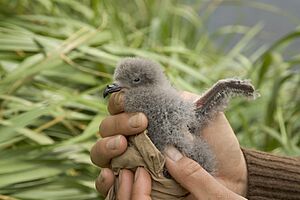
They nest in burrows they dig in soil or sand, or in small cracks in rocks. Sometimes, they have to compete with other burrowing birds for nesting spots. Colonies can be very large and crowded. For example, in the Galapagos, there can be 8 pairs of band-rumped storm petrels in just one square meter! Some colonies of Leach's storm petrel have had as many as 3.6 million birds.
Northern storm petrels are monogamous, meaning they have one partner for many years. Like other birds in their group, they lay only one egg per breeding season. If the egg doesn't hatch, they usually don't try to lay another one that year. Both parents take turns sitting on the egg, sometimes for up to six days at a time. The egg hatches after 40 to 50 days. The parents keep the chick warm for about seven more days. After that, they leave the chick alone in the nest during the day and feed it at night.
The parents feed the chick by bringing back partly digested food, which they turn into a special energy-rich oil called "stomach oil." This oil helps the chick get a lot of energy from each meal. This is important because the parents can only visit the chick once every 24 hours (at night). Chicks are ready to fly (fledge) when they are between 50 and 70 days old. This is a long time for such small birds, but it's common for seabirds. They live longer, start breeding later, and put a lot of effort into raising fewer young. The young birds leave their burrows around 62 days old. They become independent quickly and fly out to sea. They return to their birth colony after 2 or 3 years but don't start breeding until they are at least 4 years old. Some storm petrels have lived for as long as 30 years!
Dangers and Protection
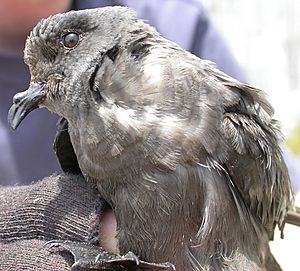
Several storm petrel species are in danger because of human activities. The Guadalupe storm petrel hasn't been seen since 1906 and is likely extinct. The ashy storm petrel is listed as endangered because its population dropped by 42% in 20 years. For the ringed storm petrel, scientists don't even know where all their breeding colonies are.
Storm petrels face similar dangers to other seabirds. A big threat is introduced species. For example, feral cats caused the extinction of the Guadalupe storm petrel. Other introduced predators have also caused populations of other species to decline. When introduced goats and pigs damage the habitat, it means fewer places for storm petrels to nest. This can also lead to more competition from other, more aggressive birds.
Storm Petrels in Culture
The name "petrel" comes from "Peter," referring to Saint Peter. It was given to these birds because they look like they are walking on water. The name "storm petrel" or "stormy petrel" comes from their habit of flying near ships during storms. Early sailors called them "Mother Carey's chickens." They believed these birds warned of coming storms. This name comes from Mater Cara, a name for the Blessed Virgin Mary.
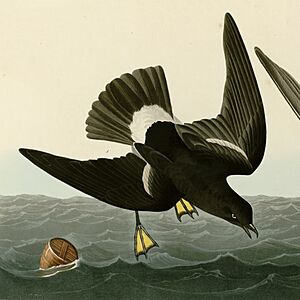
In Breton folklore, people believed storm petrels were the spirits of sea captains who were mean to their crew. These captains were doomed to fly over the sea forever. Some also thought they were the souls of drowned sailors. A common sailing superstition says that seeing a storm petrel means bad weather is coming. In Britain and France, they have scary names for these birds, like waterwitch, satanite, and oiseau du diable (devil's bird).
Symbol of Revolution
Because storm petrels are linked to stormy weather, they have become a symbol for revolutionary ideas. The term "stormy petrel" has been used to describe many different people who brought about big changes.
The Russian writer Maxim Gorky was called "the Stormy Petrel of the Revolution." This was likely because of his famous 1901 poem, "Song of the Stormy Petrel." In this poem, Gorky used the image of the storm petrel to describe how Russian society felt about the coming revolution. The storm petrel in the poem was not afraid of the storm, which represented the revolution. This poem became known as "the battle anthem of the revolution." To honor Gorky, many places and things in the USSR were named Burevestnik, which means "announcer of the storm" in Russian.
The stormy petrel has also been a symbol for revolutionary anarchism for a long time. Different anarchist groups have used the bird's name for themselves or their publications. For example, "Stormy Petrel" was the name of a German anarchist newspaper in the late 1800s. It was also the name of a Russian anarchist group in Switzerland in the early 1900s. The magazine of the Anarchist Communist Federation in Russia around the time of the 1905 revolution was also called The Stormy Petrel (Burevestnik).
Images for kids
-
The decline of the ashy storm petrel has led to it being declared an endangered species by the IUCN.
-
Painting of a storm petrel by John James Audubon



